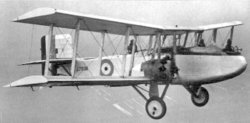Boulton Paul Aircraft Ltd
|
|
Boulton_Paul_Defiant.jpg
Boulton Paul Aircraft Ltd was a British aircraft manufacturer that operated between 1914 and 1961. The company's origins date back to an ironmonger's shop founded in 1797. By the early 1900s, Boulton & Paul Ltd was a general manufacturing firm based in Norwich, England. The company mainly built and modified aircraft under contract to other manufacturers but it had a few notable designs of its own, such as the ill-conceived Boulton Paul Defiant.
In 1915, Boulton & Paul began to construct aircraft under contract including 550 of the Royal Aircraft Factory FE.2b. During the war the company built more Sopwith Camels than any other manufacturer. Success as a builder of aircraft led to the company forming a design department but none of its resulting aircraft made a significant impact while the war lasted. The P.3 Bobolink fighter was overshadowed by the Sopwith Snipe and the Armistice beat the P.7 Bourges fighter-bomber into production.
After World War I, Boulton & Paul made their mark with the introduction of powered and enclosed defensive machine gun turrets for bombers. Their Sidestrand twin-engined biplane bomber, which could fly at 140 mph, had an exposed nose turret which was clearly inadequate. The subsequent Overstrand bomber featured the world's first enclosed, power-operated turret, mounting a single Lewis gun and propelled by compressed air. The company licensed a French design of an electro-hydraulic four-gun turret which became a major feature of their future production. In addition to fitting turrets to bombers, Boulton Paul was to install them in fighters.
In 1934, Boulton & Paul sold their aircraft division which became Boulton Paul Aircraft Ltd, based in Wolverhampton from 1936. The first "turret" fighter to be built was the Hawker Demon. This was followed by Boulton Paul's most famous aircraft, the Defiant, which was a revolutionary but flawed concept -- a "fast" fighter with no fixed forward armament but a powerful four-gun dorsal turret. The same concept was used for the Defiant's naval equivalent, the Blackburn Roc, which while designed by Blackburn, was built wholly by Boulton Paul.
Boulton Paul also built the Fairey Barracuda and did conversions to the Vickers Wellington. The only post-war design was the Balliol advanced trainer, of which 229 were built, including 30 as the "Sea Balliol" deck-landing trainer.
In the jet age, Boulton Paul worked on the English Electric Canberra and de Havilland Vampire. It designed a couple of delta-wing jets which did not enter production. In 1961 the company merged with Dowty Group to form Dowty Boulton Paul Ltd and then Dowty Aerospace.
|
Lists of Aircraft | Aircraft manufacturers | Aircraft engines | Aircraft engine manufacturers Airports | Airlines | Air forces | Aircraft weapons | Missiles | Timeline of aviation |

